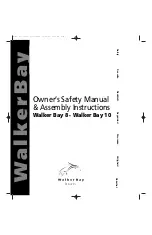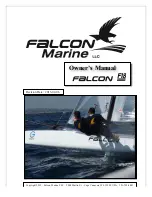
PAGE 4
GENERAL
This manual contains important information
about the safe operation and maintenance of
your Corsair built Pulse 600. Read it carefully,
become familiar with the procedures described
and follow the recommendations to help make
your sailing enjoyable and trouble-free.
Corsair trimarans are designed and built as high
performance cruising trimarans, which when
used as intended, with their enormous stability
and unsinkability, are among the safest and
fastest trimarans afloat.
PREPARATION
Before going sailing, you will need to provide the
proper safety equipment as required by local
regulations. This should include life jackets for all
crew members.
Check the weather forecast; know into what
weather you might be sailing.
OUTBOARD MOTOR
The recommended motor size is between 2 –
4HP long shaft.
There is a number of eco-friendly ‘Sail Boat’
motors now available and some of these are
designed for heavy, hard to push displacement
boats and their propellers are effectively ‘geared
down’ to give high thrust at low speeds.
However, Corsair trimarans have a very easily
driven hull and may not need such a propeller.
The result can be the same as always driving
your car in low gear.
You will have plenty of thrust, but speed is low,
and economy can be poor. These motors do
have advantages and if used, you may need
to experiment with different propellers to get
the best and most efficient performance. Refer
to the engine manual for details of operation,
maintenance and winter storage. Always be sure
you have enough fuel for your planned trip. The
motor can be used while the floats are extended
or folded but should always be tilted up when
sailing.
The dagger board should always be down when
motoring to prevent any sideways movement. If
not, the boat will have a hovercraft like motion
with wide skidding turns. With the board down,
handling is excellent.
TRAILERING
CAUTION
Measure and know the overall height on the trailer. Care
should be taken to avoid all low, overhead obstacles.
Always park into the wind or uphill to help the mast stay
in line while being winched up. Trailer should remain
hooked to towing vehicle.
The total towing weight can vary considerably depending
on options and can be determined exactly by using a
weighbridge. Check that the vehicle is approved and
equipped as recommended by its manufacturer for towing
this weight and the capacity of the towing hitch is suitable.
While towing, watch for strong crosswinds. A Corsair is a
relatively light boat for towing, but it still has considerable
windage. For easy, stable towing, the trailer should be
balanced to have 5 to 10% of the total weight on the
coupling ball. This can be measured by a bathroom scale.
If you find ‘fish tailing’ occurs, increase this weight. If
necessary, a simple change like shifting the gas tank or
outboard forward can make a considerable difference to
trailer behavior.
Trailer lights are fitted either on special brackets or as a
separate light bar on the boat’s transom. They are thus
independent from the trailer, and the wiring never gets near
the water, considerably improving reliability. If separate,
be sure to fit the correct lights on the appropriate sides.
The wire should be run along the top of the boat and then
connected to the towing vehicle. Independent wiring avoid
the frequent breakdowns that occur with wiring through the
trailer being towed on its own, the lights can be mounted
directly to the trailer.
Before trailering, check that tires are inflated correctly, the
beam locking pins are in place, the rudder is fully up and tied
to one side, the poptop or hatch is secured, and the boat is
tied down to the trailer. There should be one tie- down per
side, these being looped around the winches or brackets on
the cockpit coamings, and tied to the tie-down loops on the
trailer. The bow eye should also be tied down to the winch
post, in addition to the winch line. Check that all the trailer
supports always bear equally against the hulls.
When trailering, be sure to pivot up or remove the trailer
jockey wheel, and that the hitch is locked on to the ball.
Should the mast extend back past the trailer lights by more
than the legal amount, the appropriate warning flag should
be tied on the back. The mast can be positioned far enough
forward to eliminate any excessive over, however this may
not be possible if the towing vehicle is a van.
When trailering, always allow extra distance for stopping.
Particularly watch for low bridges, overhanging trees or
awnings etc. If necessary, the boat can be partially unfolded
on the trailer in order to pass under a low bridge.
https://www.boat-manuals.com/





































